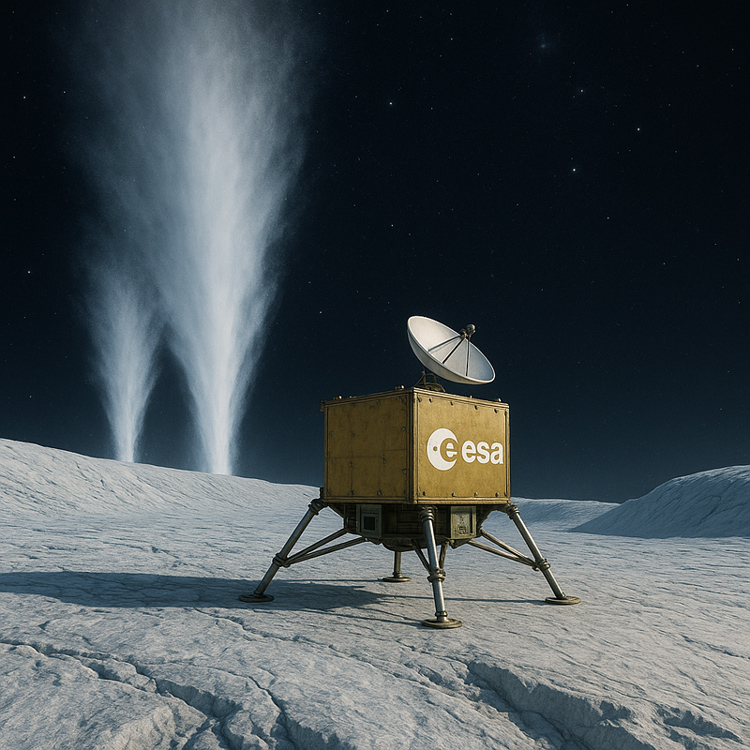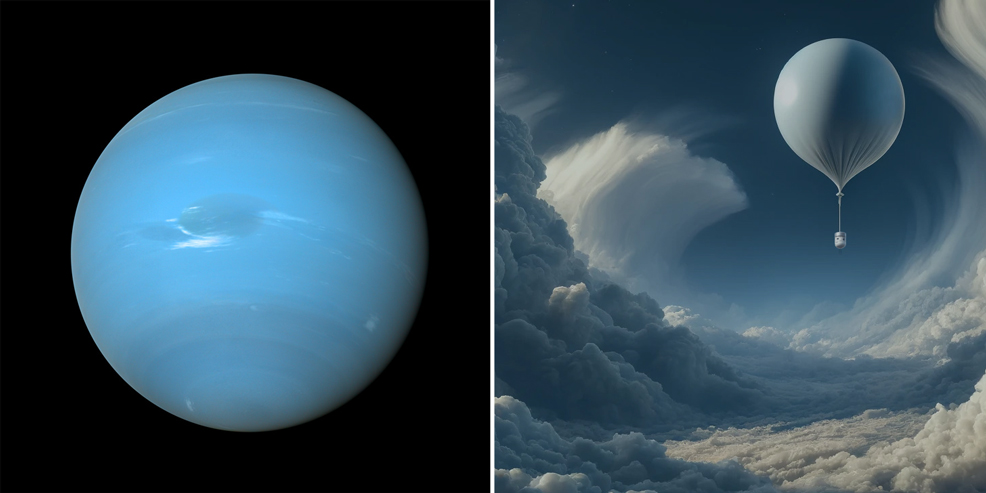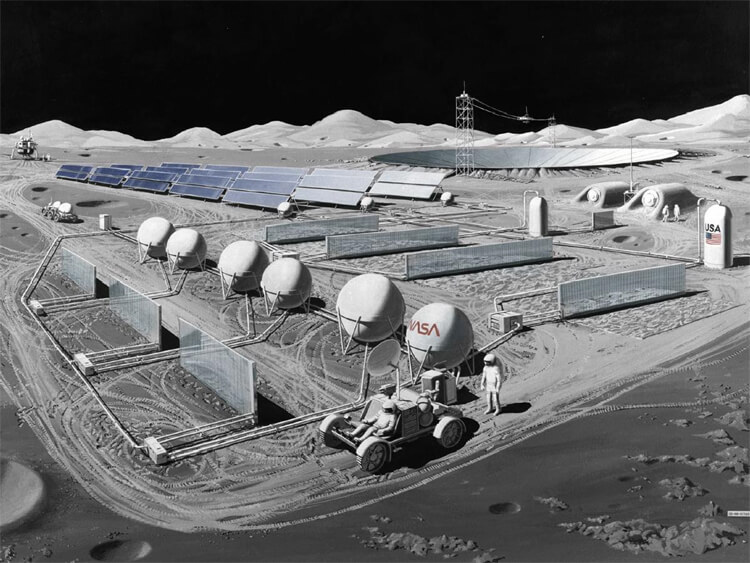
|
|
|
|
|
|
|
2058
ESA lands a probe on Enceladus
Enceladus, a small icy moon of Saturn, has long fascinated planetary scientists. In 2005, NASA's Cassini spacecraft revealed towering jets of water vapour and icy particles erupting from fractures near its south pole. These plumes indicated the presence of a global subsurface ocean kept warm by tidal heating, with organic compounds suggesting a potential habitat for life.* For decades, Enceladus remained a prime candidate in the search for extraterrestrial biology.
The European Space Agency (ESA) first outlined a mission concept for Enceladus in the 2020s, as part of its long-term Voyage 2050 plan. Early studies envisaged both an orbiter and a lander. The orbiter would investigate the plumes and characterise the moon's environment from above, while the lander would touch down near the "tiger stripe" fractures and analyse fresh material from beneath the ice. Because of the mission's high technical demands – including in-orbit docking of the two modules, long-duration cruising, and extreme environmental resilience – approval and development would take more than a decade. ESA ministers formally adopted the project in 2034, with fabrication and integration following in the late 2030s and early 2040s.
Two launches of the Ariane 6 heavy variant delivered the separate components into low Earth orbit in 2042. After docking and assembly in space, the craft then began its interplanetary journey. After a carefully timed sequence of gravity-assist flybys, it reached Saturn in 2053. Over the next five years, the orbiter would make repeated close passes through Enceladus' plumes, sampling their contents and mapping the moon in exquisite detail. This phase of the mission confirmed large quantities of organic molecules, along with strong evidence of hydrothermal activity on the seafloor.
Now, in 2058,* the lander descends to the surface. Anchoring itself on fractured ice, it deploys drills and microprobes to penetrate several metres into the crust. Instruments include mass spectrometers, chromatographs, and microscopes able to identify complex organic molecules at parts-per-trillion sensitivity. The data show a rich chemical environment and the strongest indications yet of prebiotic chemistry beyond Earth. The lander also places seismometers to measure tectonic activity and help refine models of the subsurface ocean's depth and dynamics.
This mission represents Europe's most ambitious planetary exploration to date. It marks the first controlled landing on Enceladus and the first in situ analysis of fresh material drawn directly from an ocean world. The findings provide compelling new insights into the possibility of alien life within our Solar System, while also demonstrating technologies that could one day support even more ambitious missions beneath the icy crust.

Tianwen-5 arrives at Neptune
Tianwen-5 is the fifth in a long-running series of space probes developed by China's national space agency. It follows the earlier Tianwen-4, which studied Jupiter and its moons in the late 2030s, prior to a flyby of Uranus in 2045.
Tianwen-5 is a mission to Neptune, the eighth and farthest known planet of our Solar System, 4.5 billion km (2.8 billion mi) from the Sun. This involves a journey of 18 years, launching in 2040 and arriving in 2058.* The spacecraft is an orbiter, as opposed to merely a flyby. As such, the mission can perform detailed studies of the ice giant and its moons for an extended period.
The probe is equipped with an aerostat, which is deployed separately from the main spacecraft, descending through the planet's upper atmosphere and returning a treasure trove of scientific data and imagery. Lacking a "surface", Neptune is composed primarily of gases and liquids, and has temperatures at its cloud tops approaching 55 K (−218 °C; −361 °F). In addition to extreme cold, some of the strongest winds in the Solar System are present here, reaching speeds of up to 2,100 km/h (1,300 mph).
The aerostat has been engineered to withstand these harsh conditions, with new materials and structural features to maximise its lifespan. Due to significant communication delays (over four hours one-way at the speed of light), a high degree of autonomy is also included, allowing the mission to perform tasks and make decisions without real-time input from Earth.
Tianwen-5 serves as a flagship mission for the China National Space Administration (CNSA), clearly showing that its capabilities in deep space exploration now match those of NASA.

The Beatles' music catalogue enters the public domain
Copyright law has remained largely unchanged since 2019. Accordingly, the Beatles' songs from 1962 are entered into the public domain, 96 years after the band's first single.*

A radio telescope is built on the Moon*
By 2058, a radio telescope measuring hundreds of metres wide is being developed on the Moon's far side. This provides a stable platform with slow rotation rate (0.5 arcsec/sec), beyond the interference of Earth's atmosphere and cluttered radio background. It can produce astronomical images with a clarity unmatched by any observatory on Earth or in space. Individual stars, billions of light years away, can be seen assembling into the first galaxies. The telescope is situated within an impact crater. Both it and the surrounding infrastructure are built using material gathered from the Moon itself – drastically reducing costs.*

Credit: NASA
« 2057 |
⇡ Back to top ⇡ |
2059 » |
If you enjoy our content, please consider sharing it:
References
1 Cassini proves complex chemistry in Enceladus ocean, Phys.org:
https://phys.org/news/2025-09-cassini-complex-chemistry-enceladus-ocean.html
Accessed 1st October 2025.
2 Europe wants to launch a life-hunting mission to Saturn's icy ocean moon Enceladus, Space.com:
https://www.space.com/space-exploration/missions/europe
Accessed 1st October 2025.
3 China's plans for outer Solar System exploration, The Planetary Society:
https://www.planetary.org/articles/chinas-plans-for-outer-solar-system-exploration
Accessed 18th April 2024.
4 Love Me Do, Wikipedia:
http://en.wikipedia.org/wiki/Love_Me_Do
Accessed 17th May 2012.
5 50
Years in Space: NASA's Roadmap to 2058, Space.com:
http://www.space.com/news/081001-nasa50-road-ahead.html
Accessed 13th May 2010.
6 NASA
Envisions Huge Lunar Telescope, Space.com:
http://www.space.com/businesstechnology/080716-tw-lunar-telescope.html
Accessed 13th May 2010.
![[+]](https://www.futuretimeline.net/images/buttons/expand-symbol.gif)






